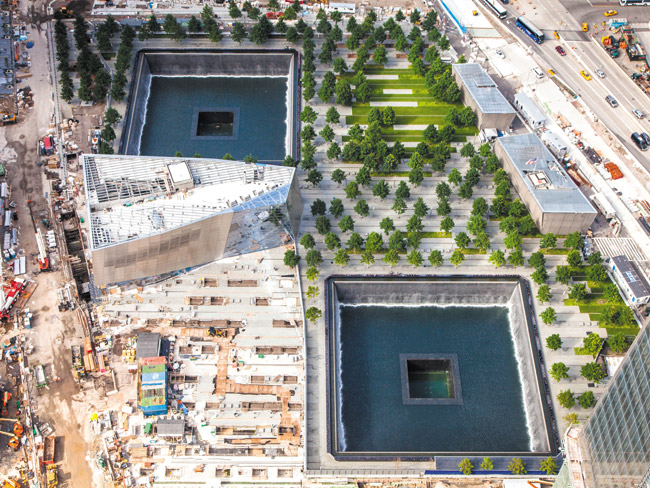Touched By Trade Center Memorial

This Joe Woolhead aerial photo courtesy of Silverstein Propeties and shot Aug. 1, 2013, shows the World Trade Center memorial park
One of the lasting realizations from our recent trip to Manhattan: The place is perpetually under repair or construction. It seems that at least half of the streets are blocked off by giant cranes, cement trucks, sidewalk scaffolding, detour signs or major excavations of some kind.
So it was no surprise when our taxi driver — a turbaned Sikh — dropped us off a block from the site of the new World Trade Center (WTC) with a nod and a grunt toward a temporary flight of stairs leading to an elevated, twisting hallway, with no signs or direction arrows. After probing several possibilities, we finally broke back into the fresh air with the 9-11 Memorial Park in sight a block away.
The truly dominant feature is, of course, WTC 1. At 1,776 feet tall (no coincidence), this “Freedom Tower” has been described in architectural circles as “shimmering perfection.” With 104 stories, it is the fourth-tallest building in the
Western Hemisphere. It will house office and retail space, restaurants and an observation deck. Like all of the new WTC buildings, it will incorporate state-of-the-art, redundant safety features: extra-wide stairs, enhanced elevators, and safety and electronic systems enclosed in an inner core wall.
Most of the WTC museum is underground, but with spacious galleries and impressive remnants of the original structures: a massive, damaged elevator motor, a segment of the TV and radio antennae atop the North Tower, the burned and twisted steel girders from the point of impact on the 96th through 99th floors of the same tower, the mangled Ladder Company 3 fire truck from NYC Fire Department, the concrete “Survivor’s Staircase” down which dozens escaped and, garnered more recently, a masonry brick from Osama bin Laden’s house in Abbottabad, Pakistan.
In Memorial Hall is a large, square gallery displaying the 2,983 photographs and names of each person who perished Sept. 11, 2001, including those who were killed in the Pentagon in Washington, D.C., in the open field near Shanksville, Pa., and in the World Trade Center bombing in February 1993. The quiet inner sanctum of this hall is a smaller square room in semi-darkness, in which projected onto the walls were more personal images of each victim with more intimate biographical information provided by their families.
The centerpiece and major focus of the memorial park are two huge, black, square pits filled by water running evenly down all four sides to just barely cover the bottoms. In the center of each pit is a square sump, which sucks the water down even farther, so the viewer from the top cannot see the last of the water as it disappears. On the black marble parapets surrounding the huge pits, which are juxtaposed corner to corner, are the engraved names of the 2,983 who lost their lives. The enormity of the space and the multitude of names underscore the vast scope of the destruction.
In studying the design-selection process, I learned the underlying theme of the design is “Reflecting Absence.” Not surprisingly, the selection committee included sculptor Maya Lin, who designed the Vietnam Veterans Memorial Wall, which posed a similar challenge.
Perhaps even more significantly, the overall design and tenor of the WTC complex clearly symbolizes the vast differences between those who brought down the towers and we who were inspired to build them in the first place, and now so quick to rebuild them. At the heart of it, our enemy is about death and destruction; we are about life and creation.
One need only recall the seemingly hopeless, smoldering mountains of wreckage and carnage left by that attack to realize the near-miraculous recovery and ultimate triumph of good over evil — again. coffee1776@gmail.com





